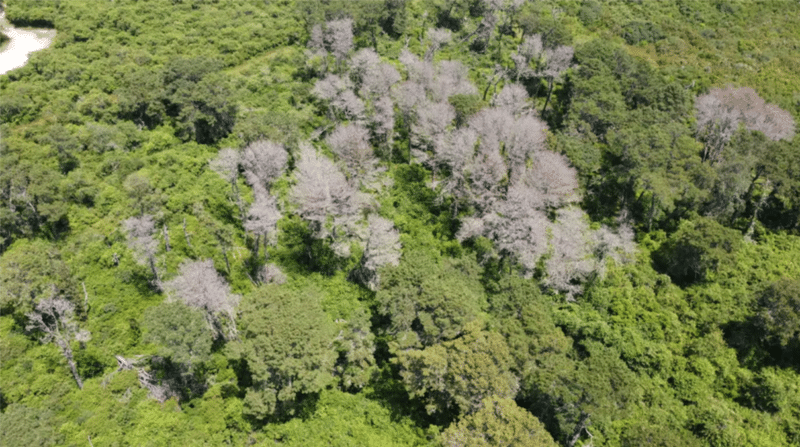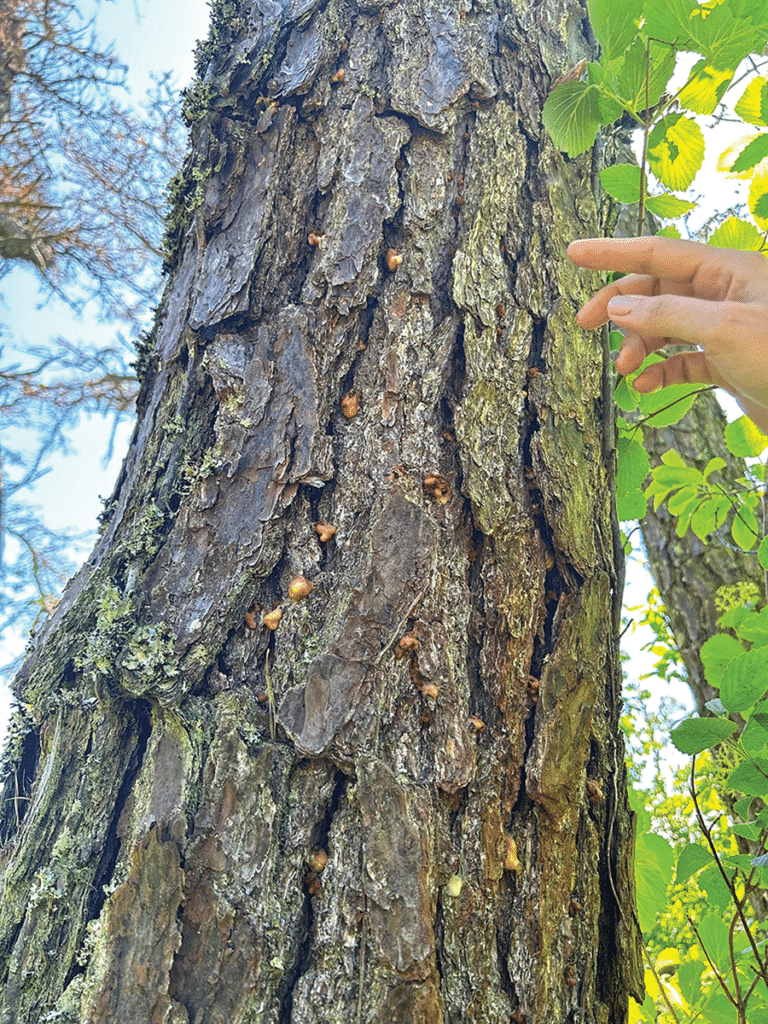by Dr. Sarah Treanor Bois, PhD
Director of Reseach & Education at the Linda Loring Nature Foundation
With our changing climate, one impact we are currently experiencing is our island is becoming hospitable to new and different species. Warmer winters, fewer cold snaps, and hotter, drier summers are welcoming a suite of new species. As some species expand their ranges into new territories, they may have little effect on the surrounding ecosystem. Other species have the potential to cause ecological and economic harm – a true invasive. The Southern Pine Beetle (SPB) is our newest Nantucket visitor wreaking havoc and causing harm to our native pitch pine stands.
The Southern Pine Beetle (Dendroctonus frontalis) is a tiny, blackish-brown bark beetle approximately one-eighth of an inch long: smaller than a grain of rice! The beetles can disperse long distances in the air currents and prevailing winds. Once they infest a tree, they release pheromones which call in other beetles, quickly overwhelming the tree’s defenses. Trees attempt to “pitch out” the beetles by pushing them out with their sap or pitch. Stressed trees cannot mount an effective defense against the SPB and quickly succumb to the infestation within weeks.
Southern Pine Beetles are native to the US, but they are typically found further south, their range originally as far north as New Jersey. With warming temperatures and available habitat—namely pitch pines (Pinus rigida)—the SPB have been moving northward. In recent decades, the beetles have been devastating pitch pine forests on Long Island, NY: SPB have caused extensive and rapid mortality of pitch pines and Japanese black pines (Pinus thunbergii) there since 2014. While pitch pines are the primary and preferred host tree, all pine trees are susceptible, including white pine and Japanese black pine.
Outbreaks of Southern Pine Beetles can very quickly overwhelm the defenses of healthy trees and cause widespread damage to pine forests. The adult beetle enters the tree through crevices in the bark and then creates S-shaped tunnels in the cambium tissue, just beneath the bark. This disrupts the flow of nutrients, typically killing the tree in 4-6 weeks. Most trees resist the initial attacks by secreting resin that can “pitch out” some adults and slow the entry of others, but trees almost always die as their defenses are overwhelmed by thousands of attacking beetles.
So far, on Long Island, more than 13,000 trees have been cut in order to slow the spread of SPB and protect surrounding trees. In all, more than 1,000 acres of pine stands on Long Island are infested.
Nantucket’s climate and ecosystems are closely related to that of Long Island, leading conservation professionals on Nantucket to be watchful of the beetles. In 2018, the Nantucket Conservation Foundation (NCF) and other conservation landowners on island began actively monitoring for SPB. Beetles had been found in low numbers since 2018. But a few beetles don’t cause an infestation.
Conservation professionals on-island have continued to educate themselves about SPB and learning about prevention. NCF staff, led by Wildlife Research Ecologist Danielle O’Dell, have been active in regional Southern Pine Beetle workshops and have developed partnerships with state and federal agencies and other conservation groups to prepare for potential outbreaks. Despite this preparation, the first infestation of SBP on Nantucket came as a surprise to many. It wasn’t so much that it happened, but we thought we’d have more time to prepare.
The first infestation was found in early July of 2023 on NCF’s property located on the southwest part the island at the West Gate entrance to Ram Pasture. The small pitch pine stand is locally known as Marvin’s Woods and has been a favorite of local birding groups and others. After spotting several dead and dying trees and suspecting SPB, NCF contacted Massachusetts Department of Conservation and Recreation staff, who visited the infected stand and confirmed SPB as the cause of tree mortality. After the initial shock, NCF staff began making a plan to mitigate the infestation and work towards preventing further spread. If left unchecked, SPB outbreaks expand: the beetles could spread to other pitch pine stands on conservation lands or adjacent private lands. Other nearby pine forests are also being monitored for signs of infestation.
According to NCF, at this point, it appears that the outbreak is contained to the one small 13-acre pine stand of Marvin’s Woods. “Unfortunately, the original estimate of ~90 infested trees has increased to ~170 since detection. Suppression efforts are continuing, and the site will remain closed to the public until the work is completed,” according to the NCF website.
Right around the time of Nantucket’s infestation, we learned about what Martha’s Vineyard was dealing with. Phillips Preserve, managed by Sheriff’s Meadow Foundation, was also battling an active infestation. In August it was reported that the infestation was expanding at a pace of 10 feet per day on MV. Since that time, our sister island is now experiencing SPB outbreaks in their state forest as well as Ripley’s Field Preserve, managed by the Martha’s Vineyard Land Bank. The Nantucket SPB Working Group and individual landowners have been working with MV colleagues to share knowledge and, in some cases, resources.
NCF is now in the active suppression phase at the infestation site. They worked with a contractor to write a suppression plan and forest management plan. Suppression efforts may include cutting of infested trees, understory thinning, and extensive monitoring of beetles. Total eradication of SPB isn’t likely because of its widespread approach throughout the Northeast. However, management can buy time and save more trees in the long-run. Management efforts for SBP include aerial and ground surveys, cutting of infested trees, and thinning of uninfested trees. Infested trees cut in the winter can reduce the population by killing the offspring that was dormant within the trees. Thinning tree stands is also beneficial by increasing the distance between trees, which can prevent beetles from communicating pheromones to nearby beetles that can kill the tree with enough numbers.
As the largest landowners on the island, NCF and the Nantucket Land Bank (NLB) have some of the largest acreages of pitch pine habitat. They’re taking that ownership seriously, doing what they can to mitigate the infestation and using preventative measures to try to limit further beetle spread.
“The Nantucket Land Bank’s goal is to achieve more resilient forests on-island. Our forest management, slated to begin this winter, will include thinning overmature and overcrowded pitch pine stands to maximize sunlight and airflow within the forest, promoting healthier trees and more diverse understories. In turn, these pitch pines will be less susceptible to wildfire and better able to fend off attack by SPB and other pests.”
The SPB issue can’t be completely solved and managed by Nantucket’s conservation professionals: much of the pitch pine habitat on-island is under private ownership. Some groups, like the Linda Loring Nature Foundation, have surveyed neighboring properties with pitch pine habitat where those forests border their own property boundaries.
What can you do to help with this work? Know the signs of SPB infestation and report what you see. Signs of a southern pine beetle infestation include: • Sudden reddening or browning of all needles. • Pitch tubes or small ‘popcorn-shaped’ resin masses on the bark all the way up the tree. • S-shaped trails or tunnels in the tissue of the tree underneath the bark. nantucketconservation.org/wp-content/uploads/2023/10/SPB-vs-BTB-082423.pdf
The Nantucket Southern Pine Beetle Working Group put together an info sheet to share information. NCF and NLB have both been leading educational tours of the pitch pine habitat and the infested area. The Nantucket Southern Pine Beetle Working Group is encouraging the public to report any trees showing symptoms of southern pine beetle infestation immediately to spb@nantucketconservation. org — be sure to include GPS coordinates, specific directions, and a photo if possible.
Looking to our Long Island neighbors, the future of our pitch pine forests can seem bleak. However, armed with the knowledge of their experiences, Nantucket’s focus on forest health management may be able to prevent significant forest loss. Be prepared this winter for forest management activities. Your favorite walking spot may be closed as these activities occur, but it is for the greater good of the property and the island forests.
All of this management takes time and a lot of money. Conservation groups and landowners are under a time crunch to get this work done and they are operating in emergency mode, pausing other projects to focus resources on the SPB work. Fingers crossed for a cold winter: SPB can’t survive in frigid temperature, which is part of the reason their range hasn’t previously expanded this far north. Let’s hope for some solid cold snaps this winter!




